This post may contain affiliate links. Please read our disclosure policy.
If you are looking for the very best vegan Tteokbokki recipe, look no further because I’ve got you covered! This Korean-inspired dish consists of chewy rice cakes cooked in a sweet and spicy Gochujang sauce. It takes just 20 minutes to prepare and is insanely easy!
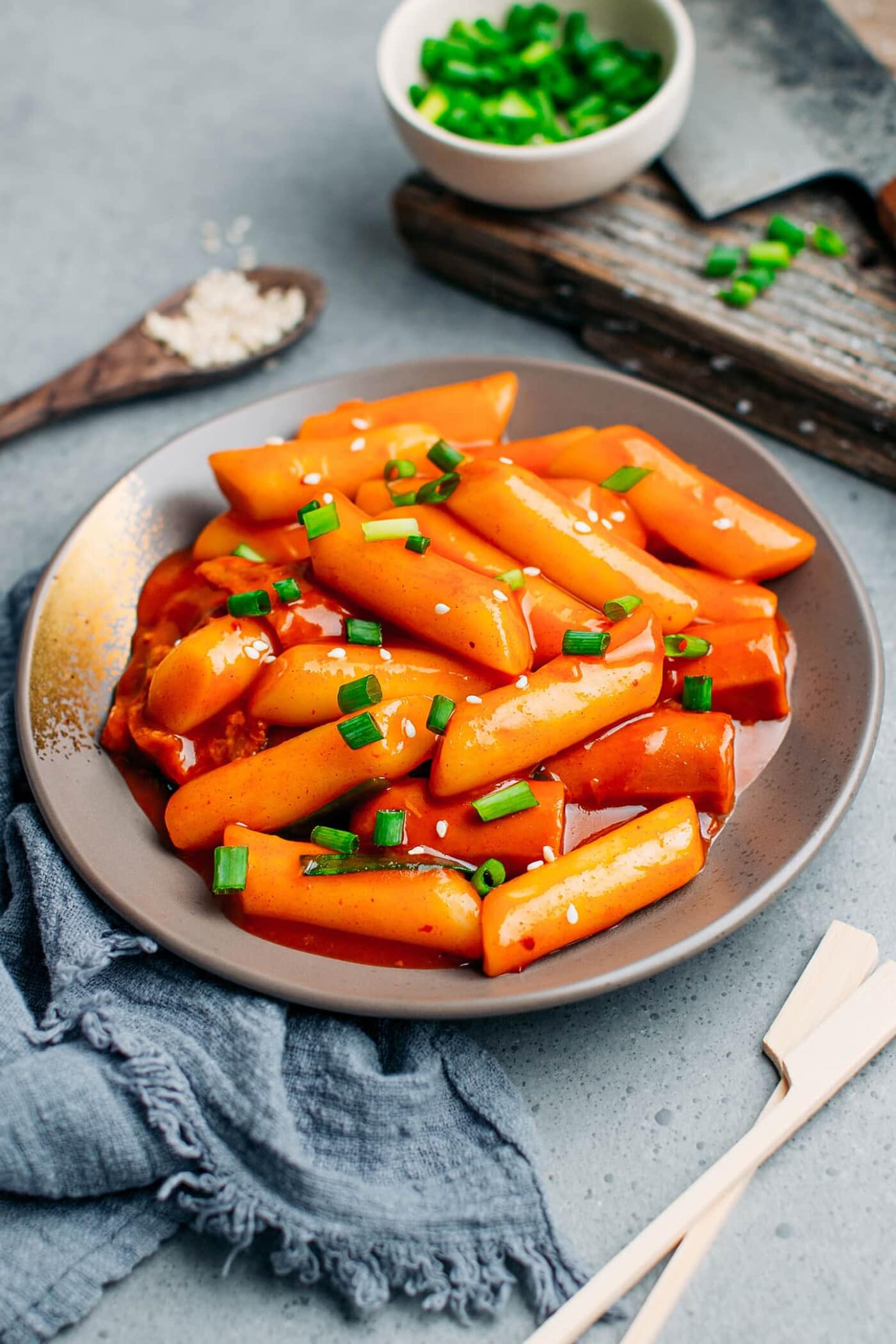
This popular Korean dish is one of my favorites! It has the perfect combination of sweet and spicy and is LOADED with flavor and texture. It’s the one recipe I make over and over again regarding the season.
After extensive research through Korean websites (as well as tasting Tteokbokki from five different Korean restaurants), I decided to develop my own version. My recipe is not as spicy as the traditional one simply because we couldn’t enjoy the dish due to the high level of spiciness. Hence, I slightly reduced the spiciness while keeping the main flavor profile.
⭐️ Why You Will Love It
Restaurant-quality at home.
Once you taste my vegan Tteokbokki and see how easy it is to make, you will never want to order from a Korean restaurant again! Unlike other recipes, I went the extra mile by incorporating vegan sausages and vegan “fish cakes” to make the dish even closer to the original. To make it short: it’s FREAKING DELICIOUS.
Perfectly balanced.
If you are like me, you probably enjoy spicy food but to a certain level. That’s why I made sure to adapt this recipe to more tolerable spiciness levels that are adapted to our foreign palates. It is not overly spicy, subtly sweet, and has a ton of flavor. Plus, the sauce is perfectly thick and coats the tender and chewy rice cakes beautifully!
One-pot and simple ingredients.
Making vegan Tteokbokki is as simple as dumping all of the ingredients in a skillet or pot and letting it simmer for 15 minutes! It requires minimal ingredients and is very easy to prepare.
🥢 What is Tteokbokki?
Tteokbokki (떡볶이) is a popular Korean street food consisting of rice cakes simmered in a spicy red chili sauce. It has recently gained popularity thanks to Korean culture’s influence through dramas, K-pop, and fashion.
There are many variations of this dish, from the original version, which consists of rice cakes cooked in a sweet Gochujang sauce, to the non-spicy alternative called Jjajang Tteokbokki, in which black bean sauce is used in place of the Gochujang.
Another popular version of Tteokbokki is called Rabokki, where instant ramen noodles are added toward the end of cooking to create different textures. Lastly, there is also Rosé Tteokbokki, which has been quite trendy recently. It’s a modern take on the traditional Tteokbokki, featuring an Italian-inspired rosé sauce made with cream.
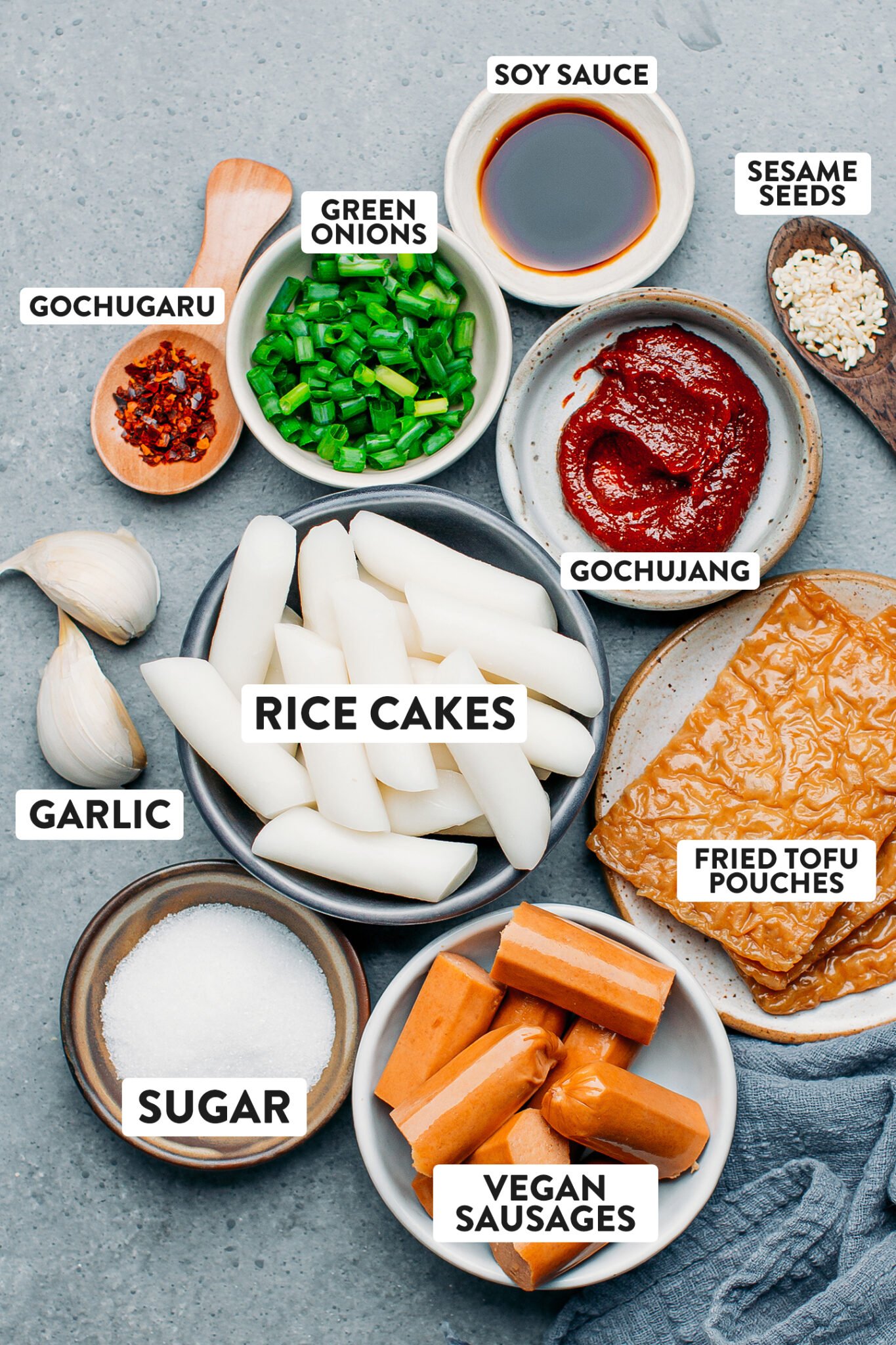
🌶 Ingredient Notes
Rice cakes
Called Garaetteok in Korean, these rice cakes are typically made from rice flour, salt, and sometimes sesame oil. Garaetteok is available in two different shapes. One comes in thick and long cylinders while the others come in discs. To make this recipe, you will need to use the cylinders.
You can find them in the fresh/frozen section of your local Asian store or get dried rice cakes here.
Dried vs. refrigerated/frozen rice cakes
You can find two types of rice cakes, the ones that are shelf-stable and the ones sold in the refrigerated/freezer section. While it obviously depends a lot on the brand, I personally had better results with the rice cakes from the refrigerated section. Those are usually fresher and become a bit more tender once cooked. I tested two different brands of Korean rice cakes:
- Wang: This brand is sold in the dried section and comes in 4 packs of 150g. What I noticed is that these rice cakes take a bit longer to cook compared to the ones sold in the refrigerated section. They are also thinner and more chewy/firmer.
- Jongga: This brand was sold in the refrigerated section of our local Asian store. It’s my preferred option for a couple of reasons. First, the rice cakes cook faster and are more tender than the dried ones. Second, they are slightly thicker, creating a chewier bite.
Gochujang
Gochujang is an essential component of the sauce. This Korean condiment is made with chili powder, fermented soybean paste, sugar, and salt. Gochujang is a flavor bomb! Think of it as a very spicy miso with smoky notes, a hint of tanginess, and complex flavors. You can find Gochujang in most Asian stores or online. There are many brands available, but my favorite is Sempio.
Note: I used 2 tablespoons of Gochujang for a mild spiciness. If you like the spiciness of instant Tteokbokki cups, for example, I recommend adding an extra tablespoon of Gochujang.
Gochugaru
Also called Korean chili powder. Gochugaru brings a subtle smokiness to the sauce as well as extra heat. I recommend adding it sparingly as it has a lot of heat that could overpower the dish. If you are unsure, start with 1/8 teaspoon of add more to your liking.
Sugar
Tteokbokki sauce is always quite sweet. The sweetness helps balance the saltiness and spiciness. While it’s not authentic, I like to use maple syrup to sweeten the sauce. I found it adds a hint of caramelized flavor to the sauce, which I prefer. However, any type of sugar works. I tried using white sugar, light brown sugar, and even agave syrup and got great results with each sweetener.
Soy sauce
To compensate for the reduced gochujang, I opted for regular Japanese soy sauce, which not only adds saltiness but also brings extra umami.
Vegan sausages
Vegan Frankfurter sausages add a meaty component to this dish and bring a smoky flavor that takes this recipe from tasty to delicious. You can find my recipe for vegan sausages here or simply use store-bought vegan Frankfurters.
Before using the sausages, slice them into 2-inch (5cm) logs and slice each log in half lengthwise.
Fried Tofu Pouches
Traditionally, Tteokbokki also includes thin fish cakes. So, how could we replace them in this vegan version? As soon as I saw what those fish cakes looked like, it instantly reminded me of Inari Age! If you are familiar with sushi, you have probably seen Inari sushi before. These fried tofu pockets are usually filled with sushi rice and garnished with different toppings.
The best part about Inari Age is that it looks and has a texture a bit similar to the thin fish cakes used in the authentic recipe. Game-changer! Plus, they are the best at soaking the sauce!
You can find Inari age online or in the dried section of most Asian supermarkets.
How to prepare the “fish” cakes
- Whisk together the marinade ingredients. In a small bowl, whisk together 3 tablespoons of water, 2 tablespoons of lime juice, 1 tablespoon of soy sauce, 1 teaspoon of maple syrup, 1 minced clove of garlic, and 1/4 of a nori sheet cut into strips.
- Marinate. Pat the fried tofu pouches dry and add them to the marinade. Toss to coat and let them marinate for about 2 hours. You can then drain them and add them to the pan.
Note: If you can’t find fried tofu pouches, simply omit them or replace them with thinly sliced fried tofu. Although those add texture and a bit extra flavor, they are not essential to this recipe.
Green onions
Green onions, or scallions, are used in both the broth and for topping. They add freshness and a delicate onion flavor. Slice the green onions you will add to the sauce into 2-inch long stalks and finely chop the ones you will use for topping.
Sesame Seeds
Used as a topping for decoration and to add a subtle nuttiness. You can use raw sesame seeds or slightly toast them for 1-2 minutes in a pan to bring out their natural nuttiness.
🥣 How to Make It
Start by preparing the sauce, a key component of this Korean dish. It packs most of the flavor as rice cakes are kind of bland on their own.
- Stir together the sauce ingredients. In a small bowl, stir together the Gochujang, maple syrup (or sugar), soy sauce, garlic, and Gochugaru (chili powder).
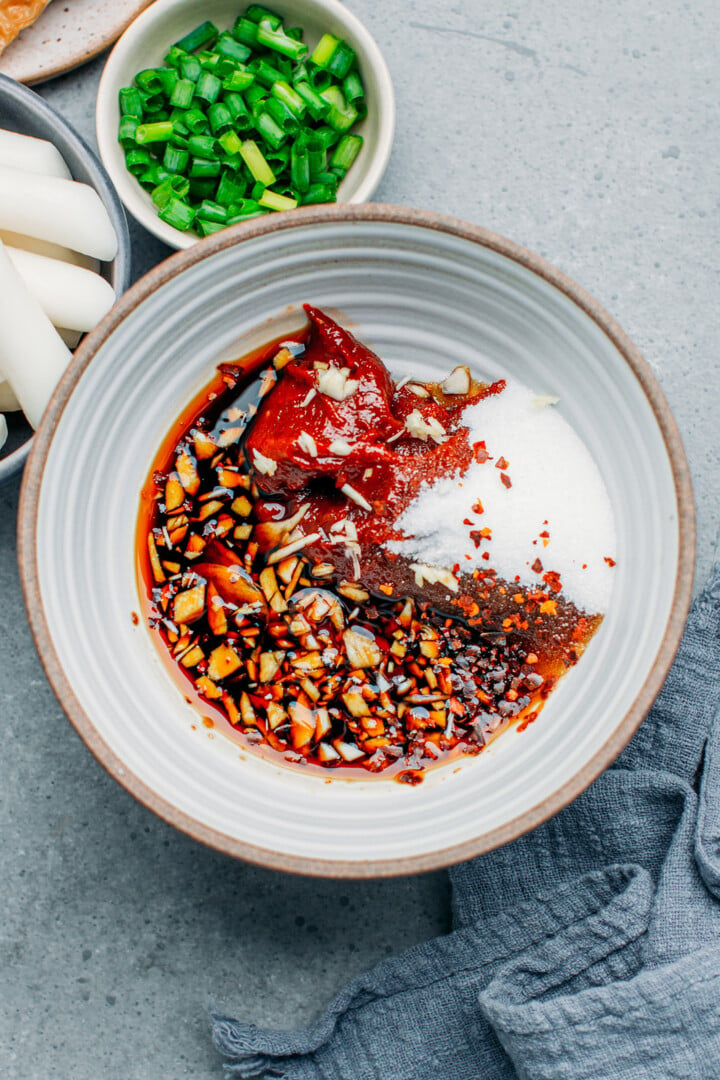

- Transfer to a skillet. Next, add the sauce and the rice cakes to a large non-stick skillet. Cover with water and bring to a simmer. I recommend giving it a stir from time to time to prevent the rice cakes from sticking to the bottom of the pan. Let simmer for about 8 minutes.
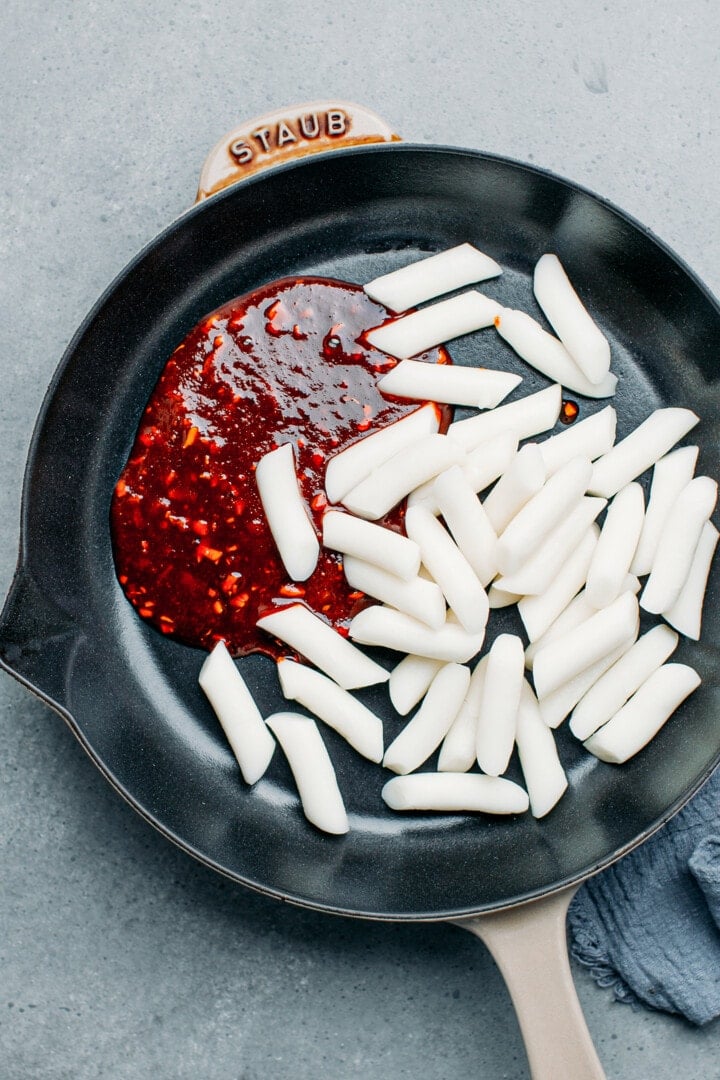
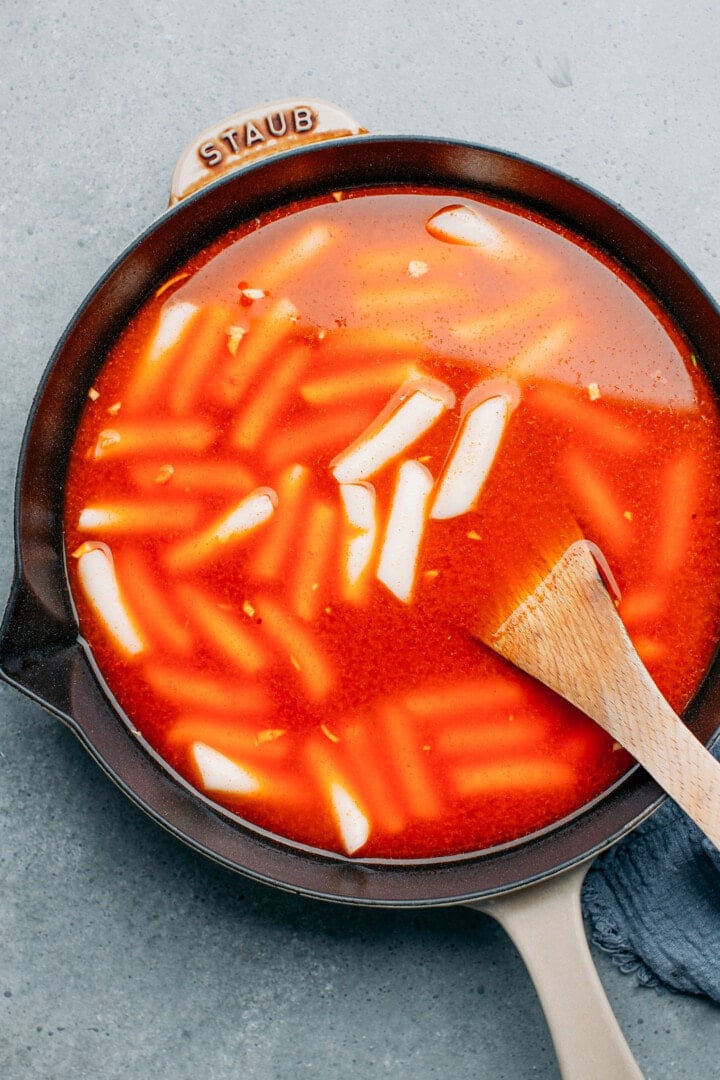
- Incorporate the add-ins. Next, stir in the vegan sausages, tofu fish cakes if using, and green onions.
- Let simmer again. Cook the rice cakes in the sauce for another 7-8 minutes. At this point, the rice cakes should be tender and chewy, and the sauce will have thickened. There is no need to add any thickener, as the rice cakes will release starch as they cook, helping the sauce thicken naturally.
- Serve. Finally, transfer to serving plates or bowls and garnish with chopped green onions and toasted sesame seeds!


🥬 How To Serve It
You can serve this Tteokbokki as is or top it with grated vegan cheese for even more deliciousness! It also tastes great served with some vegan kimchi on the side.
📔 Tips
- Adjust the spiciness level. This recipe yields a mild spiciness. Depending on your tolerance, you can adjust the heat of this dish by using more or less Gochugaru (chili powder). If you are looking for a non-spicy version of Tteokbokki, check out my Jjajang Tteokbokki recipe.
- Let simmer until the sauce has thickened. This is key! The rice cakes must simmer for at least 15 minutes or until the sauce has thickened. I noticed that if the sauce is too liquid, the rice cakes don’t taste as good simply because the sauce doesn’t coat them well enough.
- Do not overcook it either. Once the sauce starts to thicken and the rice cakes are tender, remove from heat. The sauce will continue to thicken a bit as it cools down.

❄️ Storing and Reheating
- To store: Although Tteokbokki tastes best when served right after cooking, it can be stored in the refrigerator for up to 2 days.
- To reheat: You can reheat Tteokbokki in a skillet or saucepan over medium heat for 5-7 minutes. I usually add a few tablespoons of water as the sauce tends to thicken after a while.
💬 FAQ
You should easily find rice cakes in Asian stores, sold dried or frozen. If you have time, it’s also possible to make your own. There are many recipes online.
I would say it is mildly spicy. If you are not used to spicy dishes, you will probably find it quite spicy. You can adjust the spiciness by using less Gochujang/Gochugaru and adjusting the saltiness to taste.
Yes, it will work just as well!

I hope you will love my take on this Korean classic! It is flavorful, spicy, comforting, and surprisingly easy to make!
🍜 More Korean-Inspired Recipes
⭐️ Did you like this recipe? Let us know in the comments below, and tag us on Facebook, Instagram, or Pinterest!
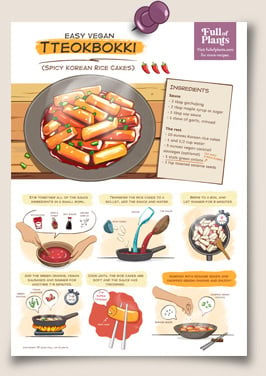
Print the Illustrated Recipe!
Put it in your recipe binder or hang it on your fridge with a magnet!


Save this recipe!
Enter your email below and I’ll send it to your inbox!
Plus, you will receive new recipes every week!

Easy Vegan Tteokbokki (Spicy Korean Rice Cakes)
Ingredients
Spicy Sauce
- 2 tbsp (36 g) gochujang
- 2 tbsp (30 ml) maple syrup or granulated sugar
- 1 tbsp (15 ml) soy sauce
- 1 clove of garlic minced
- 1/4 tsp gochugaru (Korean chili powder)
Main Ingredients
- 10 ounces (300 g) Korean rice cakes
- 1 and 1/2 cup water
- 5 ounces (150 g) vegan cocktail sausages optional
- one batch of vegan "fish" cakes optional, see notes
- 1 stalk green onions cut into 2-inch strips
- 1 tsp toasted sesame seeds for topping
Instructions
- Prepare the spicy sauce: in a small bowl, stir together the sauce ingredients until fully combined.
- Transfer the sauce to a skillet or large saucepan. Add the rice cakes and cover with the water. Bring to a boil, reduce the heat, and let simmer uncovered for about 8 minutes over medium heat.
- After 8 minutes, stir in the green onions, vegan cocktail sausages, and vegan "fish" cakes if using. Let simmer for another 7-8 minutes or until the rice cakes are very tender and the sauce has thickened. If the sauce is too thick, feel free to add more water.
- Divide between serving bowls and top with toasted sesame seeds!
- Tteokbokki will keep for up to 2 days in the refrigerator. Reheat over medium heat for 7-8 minutes, adding a few tablespoons of water if the sauce is too thick.
Video

Notes
- Adjust the spiciness level. This recipe yields a mild spiciness. Depending on your tolerance, you can adjust the heat of this dish by using more or less Gochugaru (chili powder).
- Do not overcook it. Once the sauce starts to thicken and the rice cakes are tender, remove from heat. The sauce will continue to thicken a bit as it cools down.
- Dried rice cakes vs. refrigerated/frozen ones. You can find two types of rice cakes, the ones that are shelf-stable and the ones sold in the refrigerated section. While it obviously depends a lot on the brand, I personally had better results with the rice cakes from the refrigerated section. Those are usually fresher and become a bit more tender once cooked.
- If you want to make “fish cakes,”: Marinate 7-8 thin slices of fried tofu (or inari age) for at least 2 hours in: 2 tbsp lime juice, 1 tbsp soy sauce, 1 tsp maple syrup, 3 tbsp water, 1/4 sheet of nori cut into strips, 1 clove of garlic, minced. Drain before using.
Nutrition

About the Author
Thomas Pagot is the founder, photographer, and recipe developer behind Full of Plants. He created the blog in 2016 as a personal cookbook for vegan recipes. Through years of recipe development, Thomas has successfully grown Full of Plants into a trusted resource for plant-based recipes.







Leave a Comment
Thank you for the recipe! Something went wrong on my end somewhere because it ended up being really sweet and not very spicy lol I had a hunch to add only half the sweetener amount but didn’t. Still it was exciting trying to make (and eat) tteokbokki for the first time!
Hi Becka,
What kind of gochujang did you use? I’m really surprised it was not spicy with 2 tablespoons of gochujang (I generally only use 1 tbsp and I find it already quite spicy!).
My guess is that your paste was not real gochujang.
Super simple and delicious. I subbed deep fried tofu for the hot dogs as I didn’t have any and used bean curd tofu sheet instead of the fish as I don’t eat fish
Sounds like tasty additions! Thanks for your feedback Alex!
The best vegan tteokbokki recipe I have ever tried! Simple yet delicious. I’ll rate your recipe 5* to thank you for your excellent job.
Lee M.S
Thank you so much for your feedback Lee! 🙂
Excellent! Love it!
Thanks Ben! Your tteokbokki looks great!
Hey Thomas!
I’ve been looking for a good Tteokbokki recipe for a long time and you saved me! This was so so so so goooood!!! I can’t tell you how much I’ve enjoyed it; I’ve been craving Tteokbokki for several weeks and yeah, definitely gonna make more of your delicious looking recipes!!
Cheers!
Hey Lumuna,
I’m so happy to hear you liked this vegan tteokbokki recipe! Thanks for your feedback 🙂
This was soooo good! It was the first time that I not only cooked tteokbokki but also even tried them. I added a couple of carrots, some mushrooms and a red pepper for some extra veggie goodness. I also used vegan sausages and it added that smoky flavour. I loved it and I think I just found my new go to comfort meal! Thanks! 😀
You are welcome Sabrina! Thanks for your feedback 🙂
And I agree, the smoky flavor that vegan sausage brings really takes the dish to another level.
AMAZING dish. I usually just season my own dishes cuz I find a lot of recipes are under seasoned, but I always follow this recipe to a T whenever I make it, and it turns out PERFECT every single time. Made it for a potluck and it was super popular! Seriously my new favourite comfort food. Thank you so much for this!!
Awesome! Glad you enjoyed this recipe 😉
Thanks for your rating!
Wow, this recipe seems amazing. And the photos look mouth-watering. I can’t wait to try it. I have been a vegetarian for a year and I don’t even miss eating meat at all. However, it’s not easy to find vegan recipes that are perfect to my liking. Especially when it comes with Korean and Japanese food. Then, one of my friends from Korea showed me your blog. Tbh your great recipes never disappoint me, Thomas. Keep up the good work!
Thanks Miyoshi! Hope you will like this Tteokbokki recipe!
Sounds delicious-I can’t wait to try it. Thank you!
Hope you will like it Candice!
You made 떡볶이! This is my soul food. I’m living in the U.S so when I miss my country food I make 떡볶이.
People in Korea have different preferences when it comes to the tteokbokki. Of course, the main ingredients are pretty much the same: rice cakes. Spicy Rice Cakes, Gungjung Tteokbokki (궁중 떡볶이, Royal Court Rice Cake), Soupy Spicy Rice Cakes (국물 떡볶이, gukmul tteokbokki), Pan-fried Rice Cakes (기름 떡볶이, girum ttoekbokki)….
You can make 떡볶이 in hundreds of different ways by choosing 떡볶이’s ingredients, such as any vegetables, vegan cheese, nutritional yeast … and you can skip gochujang(고추장), gochu garu(고춧가루).
Today, I’m going to make 떡볶이. You made my day!
Thanks for your input Park! 🙂 I’m sure melted vegan cheese on top would taste amazing!